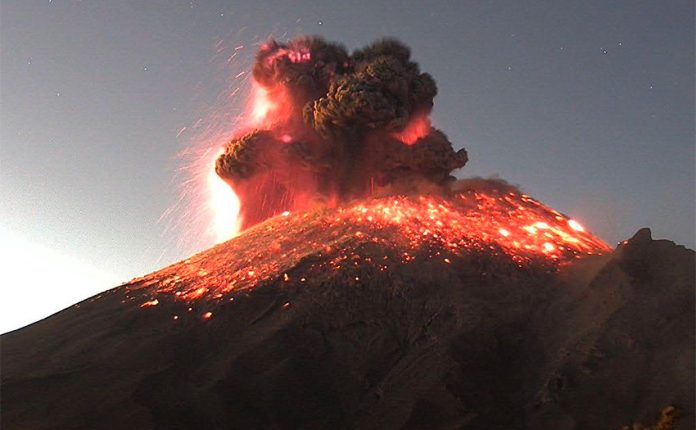A spectacular eruption at the Popocatépetl volcano early Thursday sent a three-kilometer column of smoke and ash into the sky and launched incandescent rocks a kilometer down its slopes.
El Popo, as the volcano straddling the states of México, Puebla and Morelos is commonly known, erupted at 6:31am, according to the national Civil Protection service. Ash fell in towns in several municipalities in the vicinity of the 5,426-meter-high conical volcano.
Civil Protection chief Luis Felipe Puente said the eruption at Popocatépetl was within the range of what is considered normal and therefore the alert level would be maintained at yellow Phase 2.
The warning recognizes that there is increased activity at the volcano but is only the fourth highest of seven alert levels in a three-tier “traffic light” system. A 12-kilometer security radius remains in place around the base of El Popo.
Puente said that wind took ash in a north-northeasterly direction after the early morning eruption.
The Morelos government said that its monitoring systems detected 268 exhalations of water vapor, gases and ash after the large eruption, which was even detected by satellites in space. It also said that a 1.4-magnitude volcano tectonic earthquake occurred at 10:04am.
Puebla Civil Protection authorities said the municipalities of San Nicolás de los Ranchos, Chiautzingo, San Matías Tlalancaleca and Teotlalcingo all received a light dusting of ash.
Authorities recommend the use of face masks by people who live near the volcano because fine ash articles can remain suspended in the atmosphere f0r weeks.
Thursday’s volcanic activity follows a particularly active 2019 for Popocatépetl, with numerous eruptions including one in June that emitted a plume of ash that rose between four and five kilometers above its crater
December 21 marked the 25th anniversary of renewed activity at the volcano located about 90 kilometers southeast of Mexico City. On that day in 1994, El Popo erupted for the first time in 56 years.
Source: La Jornada (sp), EarthSky (en)
